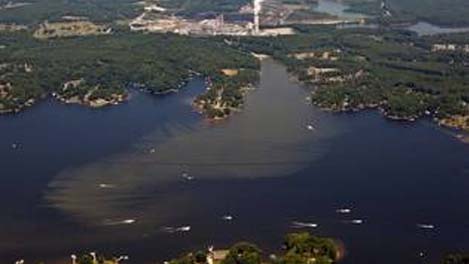The calls began pouring in to Mecklenburg County environmental officials a couple of weeks ago: What s with the massive oil slick on Lake Norman, concerned residents wanted to know.
Three or four miles of the lake s surface had turned dark brown, extending along the main channel from near the N.C. 150 bridge in the Mooresville-Terrell area south to the Little Creek section in eastern Lincoln County.
Another patch was spotted farther south at the dam at McGuire Nuclear Station in Huntersville, and parts of the slicks remain, fishermen reported this week.
While Mecklenburg County handled 20 calls from concerned residents, longtime Lake Norman fishing guide Gus Gustafson fielded 12 to 15. Members of the Lake Norman Marine Commission also got numerous calls.
Charlotte-Mecklenburg police sent a helicopter over the lake, and marine commission Chairman Ron Shoultz of Iredell County had his neighbor fly him over the slick in the neighbor s sea plane.
It turned out naturally occurring algae are to blame.
Mecklenburg County took samples and found no petroleum in the various types of the aquatic plant that form the massive sheen, said David Caldwell, environmental supervisor for Mecklenburg County s Water Quality Program.
Caldwell s department had a lab run chemical screenings for volatile organic compounds and metals, but found none. Metals looked normal, except for slightly elevated iron and manganese, which is common for bottom water, Caldwell said. Oxygen, pH and conductivity were all normal as well.
Safe to swim
Caldwell said it s safe to swim in the algae, which are commonly referred to as brown scum, as none of the varieties is known to be toxic in North Carolina s largest manmade lake.
A sample of the algae collected Aug. 2 at Blythe Landing in Huntersville was fairly typical for brown scum that we commonly observe in the fall when the lake turns over and fine material from the bottom is brought up to the surface, said David Buetow, senior environmental specialist with Charlotte-Mecklenburg Stormwater Services.
Our guys saw some dead stripers out there, but we don t think it s related to (the appearance of the algae), Caldwell said.
Iredell County environmental health officials also took samples, and tests turned up negative for fecal matter and heavy metals, Shoultz said.
The algae were most likely sucked up from the bottom of the lake as part of normal operations at Duke Energy s Marshall Steam Station in Terrell and its McGuire Nuclear Station off N.C. 73. They were then hurled back with warm water discharges from the plants onto the lake s surface, Caldwell said.
This summer s hotter-than-normal water temperatures also could prompt more algae to rise to the surface than in years past, Caldwell said.
Gustafson said highs have reached 87 to 90 degrees in the water this summer, varying by location.
The water is 3 degrees higher than last year at this time, Shoultz said.
While algae rise to the surface every year, Caldwell said, this is definitely more extensive. We ve never gotten calls like this.


